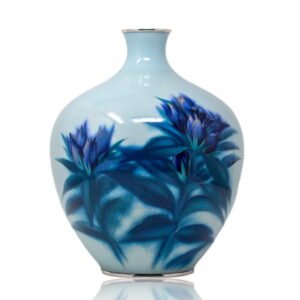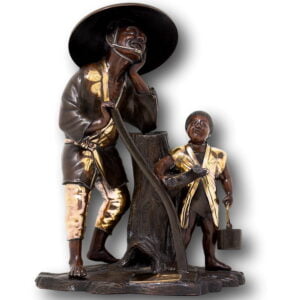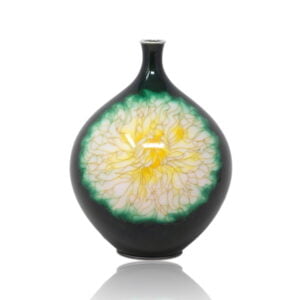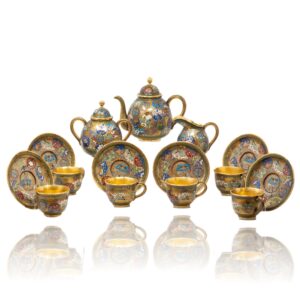Description
Large Sized Pottery Vase
From our Japanese Satsuma collection, we are pleased to offer this Japanese Satsuma Vase by Chikusai 竹斎.
The vase is of large ovoid form with a waisted neck and flared foot rim, extensively decorated with a continuous scenic design. The central band depicts a mountainous landscape with bijin and children in the foreground among trees, rivers, and blossoms, while further figures and buildings are scattered across the scene.
The decoration is enriched with gilt borders, including floral motifs, coloured fans, and roundels near the shoulder, while the base features scrolling gilt vines with a geometric pattern. The vase is signed to the underside with the Shimazu clan crest and the artist’s signature for Chikusai 竹斎.
Dating to the Meiji Period (1868–1912), this large vase exemplifies the detailed and narrative qualities admired in fine Satsuma pottery.
Shimazu Mon
Shimazu 島津 is the name of the clan family that ruled the Satsuma province and the family crest, the Mon is a cross with a circle. The earliest Shimazu Mon was painted in Gosu blue and was believed to be painted in direct relationship to the Shimazu clan and often pre Meiji Period. A mon that is depicted in black, gold or red has no direct link to the Shimazu family and always dates from a period after Edo.
MEIJI PERIOD (1868-1912)
The Meiji era marked Japan’s transformation into a modern nation and a golden age of decorative arts. With the end of samurai rule and Japan’s opening to the West, artisans produced works of exceptional quality for both domestic and international audiences. Supported by the government through world fairs and Imperial commissions, Japanese lacquerware, cloisonné, satsuma ceramics, bronzes, and ivory carvings reached collectors worldwide. Many leading artists of the time, including Makuzu Kozan and Namikawa Yasuyuki, were honoured as Imperial Household Artists, ensuring the Meiji period remains one of the most celebrated eras of Japanese art.
For further information please see our article Japanese Meiji Period: Art, Collecting, and Cultural Transformation.
SATSUMA WARE
Satsuma ware originated in southern Kyūshū around 1600 and developed into one of Japan’s most recognisable ceramics. Early Ko-Satsuma pieces were rustic, dark-clay wares made for everyday use, while the later Kyō-Satsuma style became famous worldwide during the Meiji period.
Characterised by ivory crackled glaze, delicate overglaze enamels, and lavish gilding, export Satsuma appealed strongly to Western collectors. Designs often feature landscapes, flowers, figures, and scenes from Japanese life and mythology. Renowned artists such as Yabu Meizan, Ryozan, and the Kinkōzan workshop produced some of the finest examples, which remain highly sought after today. Genuine Satsuma can often be identified by the Shimazu crest, artist signatures, or the mark “Dai Nippon” used during the Meiji era.
For further information on the history of Satsuma Wear please see our article Japanese Satsuma Ware.
MEASUREMENTS
31cm High x 19cm (12.2 x 7.5 Inches)
CONDITION
Excellent – minor wear / rubbing only
With every purchase from Jacksons Antique, you will receive our latest product guide, certificate of authenticity, full tracking information so you can monitor your shipment from start to finish and our personal no-hassle, money-back policy giving you that extra confidence when purchasing. Don’t forget to sign up to our free monthly newsletter for 10% off your first online purchase.
































